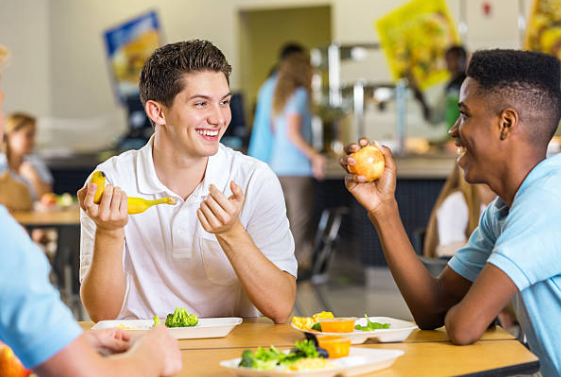Peer Review: A Five-Part Unit for Teaching Healthy Nutrition to Adolescents

Previously published in Volume 83, Issue 2
Abstract
The paper introduces a concept of a teaching unit designed as a framework for teachers to adapt to their classes when teaching about healthy nutrition. It serves as a guidance for a motivating approach to healthy nutrition in lower secondary school, as it relates to students’ lives and makes use of explorative learning methodology, with as little teacher interference as possible. The unit consists of five parts which will be presented in more detail in the paper. Each of the parts is centered around theoretical input and experiments about the five main macro and micro nutrients (proteins, carbohydrates, fats, vitamins, trace and bulk elements, as well as fibers). Results of EsKiMo study (Richter, Vohmann, Stahl, Heseker & Mensink, 2008) and the HELENA study (Moreno, Gottrand, Huybrechts, Ruiz, Gonzales, Gross & DeHenauw, 2014) showed a lack of healthy eating behavior of adolescents across Germany and Europe. Yet, healthy nutrition is the key component for our bodies to function optimally and to prevent chronic diseases. Teaching about healthy nutrition at school can be a crucial step toward building a solid basis for students’ later lives with regards to their eating behavior and attitudes towards nutrition and a healthy lifestyle (Macera, 2010, p. 8). The unit is thus designed to positively impact student attitudes and behavior regarding nutritional behavior.
Background
As obvious as it might seem, food is essential for our bodies since it is needed:
- to develop, replace, and repair cells and tissue
- to produce energy to keep warm, move, and work
- to carry out chemical processes, such as the digestion of food
- to protect against, resist, and fight infection or recover from sickness (Food and Agriculture Organization of the United Nations, 2002, p. 13).
Healthy nutrition is the key to optimally run our bodies. Healthy nutrition and physical activity are also important for reducing “rates of disease and deaths from chronic disease” (Macera, 2010, p. 2). For nutrition to be healthy, experts recommend to eat a variety of foods to ensure sufficient supply of all required nutrients. In addition to staple foods (e.g., rice, grains, tubers, potatoes, etc.) with every meal, one should also include legumes, fruit, and vegetables in meals every day. Animal and milk products should be consumed on a regular basis. Additionally, the desirable fat and oils should be consumed more often than less healthy fats. A sufficient fluid intake completes these recommendations (FAO, 2002, p. 13-16).
The Healthy Eating Plate created by nutritional experts of the Harvard School of Public Health and editors of the Harvard Health Publications can serve as a guide to make the best eating choices and illustrates the recommendations for a healthy diet in a clear and simple way (for more information see https://www.hsph.harvard.edu/nutritionsource/healthy-eating-plate/.
In 2006, the EsKiMo study investigated the eating habits of 2,506 six- to 17-year-old children in Germany (Richter, Vohmann, Stahl, Heseker & Mensink, 2008). Two kinds of survey methods were used in the study: six- to 11-year-old children had to write an eating protocol in which they noted down the brand name, the amount, place and time, preparation method, and a list of ingredients for home-made meals. For the 12- to 17-year-old children, a standardized interview was used. Results of the study showed that the consumption of meat, sausage products, and meat products was clearly above the recommended amount and particularly high for the group of 12- to 17-year-old boys. The consumption of fruit and vegetables was clearly below the recommended amount: only 33% of girls and 27% of the boys within the group of the six- to 11-year-old children, and 47% of the girls and 29% of the boys within the 12- to 17-year-old group reached the recommended amount. Almost none of the participants reached the recommended amount of carbohydrates (from bread, rice, potatoes, noodles, etc.). Children consumed many sweets, much fat and lemonade (up to three times more than the actual guideline). Within three weeks, 96% of the participants consumed fast food at least once (Richter et al., 2008).
On a larger scale, the HELENA study investigated the nutritional state of adolescents in Europe (Moreno, Gottrand, Huybrechts, Ruiz, Gonzales, Gross & DeHenauw, 2014). Participants lived in 10 cities with more than 100,000 inhabitants and were asked about aspects such as dietary intake, food choices, physical activity, and fitness. The study made use of self-reported 24-hour recalls and a questionnaire which evaluated the participants’ breakfast intake. Results showed that only half of the adolescents asked ate breakfast, while one quarter of the males and one third of the female participants skipped it.
Most of the adolescents asked only ate half of the fruit recommended and less than two thirds of milk products. Yet they ate more meat products, fats, and sweets than recommended. Water was consumed by the majority of adolescents, followed by sugar-sweetened beverages. While the intake of salt and saturated fatty acids was too high, that of polyunsaturated fatty acids was too low as well as that for vitamin D, folate, iodine and fluoride (Moreno et al., 2014).

The results of these studies display a clear tendency towards a rather unhealthy diet of adolescents in Germany and across Europe. Keeping this in mind, the importance of prevention efforts for older children become even more crucial. Dealing with healthy nutrition and physical activity at school can build a basis for the children’s lives (Macera, 2010, p. 5), as “coordinated school health programs have the potential to help young people adopt and maintain healthy eating and physical activity behaviors” (Macera, 2010, p. 8) Schools should help students develop skills, knowledge and attitudes necessary to adopt and maintain healthy eating and physical activity behaviors (Macera, 2010, p. 8).
When it comes to modifying adolescents’ nutritional behavior, the theory of reasoned action (TRA) and the theory of planned behavior (TPB) are said to provide a prediction of certain health behaviors, which also include nutritional choices (Montano & Kasprzyk, 2015, p. 95). TRA suggest that the most important determinant of behavior is behavioral intention. Behavioral intention in turn is influenced by an individual’s attitudes towards performing a certain behavior as well as subjective norms associated with a particular behavior (Montano & Kasprzyk, 2015, p. 97). Positive attitudes towards the behavior thus result from a person’s beliefs about positive outcomes of that behavior (ibid.). An individual’s subjective norm is determined by positive normative beliefs, which describe important referents “approve or disapprove of performing the behavior” (ibid.) Positive subjective norm would imply that a person thinks that certain referents approve of the performance of a certain behavior (ibid.).
Figure 1. Theory of Reasoned Action(TRA) and Planned Behavior (TPB) taken from Montano and Kasprzyk, 2015, p. 97. Grey marks those additional components of TPB
The component of perceived behavioral control adds to the model of TRA, as it describes factors outside individual control as an additional influence on intentions to perform a behavior (Montano & Kasprzyk, 2015, p. 98). This extension creates the theory of planned behavior (TPB, see figure 1). Perceived control is in determined by control beliefs (“presence or absence of facilitators and barriers of behavioral performance”, Montano & Kasprzyk, 2015, p. 98) and perceived power (“impact of each control factor to facilitate or inhibit the behavior”, ibid.).
Taking these theories as a basis, the unit can influence/change the students’ behavior by influencing their attitude toward healthy nutrition through awareness raising and conscious exploring of aspects of a healthy and balanced nutrition. A rather inquiry based approach to the topic which includes establishing a connection to the students’ lives and letting them explore a problem/phenomenon autonomously (see figure 2 for general lesson structure) is assumed to affect and change their nutritional behavior. Students actively engage in experiments which enable them to discover the processes underlying the digestion of nutrients. The teacher can serve as a role model when it comes to the consciousness-raising of (healthy) eating, thus influencing the students’ normative beliefs.
The unit
The unit serves as a framework for teachers to designing a unit about healthy nutrition. It provides a broad approach towards the topic and can be adapted and changed to meet the needs of particular classes. It is designed for older students in secondary school (around 15 years old), since they have sufficient prior knowledge to understand the unit thoroughly (e.g., the biological and chemical basis they need for understanding the processes involved in human metabolism or cellular respiration). The unit is intended to convey knowledge but also to motivate students to apply their acquired knowledge in real life. It is strongly related to the students’ lives and seeks to motivate them intrinsically. To foster this type of motivation, student centered approaches which foster autonomy were chosen (e.g., a strong focus on experiments and group work).
Figure 2. Schema of the general lesson structure.
The unit consists of five double lessons of 90 minutes. The division into individual lessons is based on five substance classes of macro and micro nutrients (proteins, carbohydrates, fats and vitamins, bulk and trace elements, as well as fibers). There is one experiment for each nutrient. These experiments will be presented in detail in the following sections for teachers to adapt them to their classes.
Each of the five 90 minute lessons follows a general structure (which is also shown in figure 2): Lessons usually start with a connection of the topic with the students’ everyday lives. Before the experiment can be carried out, the knowledge necessary to understand it needs to be conveyed. This is usually done by having a short teacher- centered phase at the beginning followed by a group puzzle. Here, the class is divided into groups of the same size (e.g., A-E with four members each). Each group then receives a text which deals with a particular part of the digestion process. Group members then read and work though the text (it has to be noted that texts have to be selected individually, depending on the particular class). Then, groups are rearranged in a way that each group is made up of members of each of the former groups (e.g., A,B,C,D,E, see figure 3). In this setting, each member tells the others about the content of their text part. This way, the group puzzle creates a (theoretical) framework for students to work on and evaluate experiments.
The group puzzle working phase leads over to the experimental phase of the lessons. When working on the experiments, groups should not be too big, since students are to be actively involved in the process of experimenting. The teacher only has a supporting role during this phase, answering questions, providing help when necessary and watching out for students noting down their observations and results.
Figure 3. Schema of a group puzzle
A discussion phase follows the experimentation in small groups. Here, results and observations are collected and related to the theoretical frame. It is important that students draw their own conclusions with the teacher guiding them towards an individual understanding. The teacher then helps to transfer the results to real processes related to digestive processes. Nevertheless, s/he also stresses the differences between in vitro and in vivo and the fact that experiments only exemplarily recreate reality. The final part of lessons should consist of the teacher’s choice of an assessment of the newly acquired knowledge. One interesting and motivating way could be using a Power Point with multiple choice questions about the lesson. Other, more traditional forms, such as a pen and paper test, could be used as well. The type of assessment depends on the students of a particular class: a quiz such as the Power Point version for example might not be suitable for turbulent classes.
The following section describes the experiments implemented in the unit in more detail. They are divided into proteins, carbohydrates, fats, vitamins, trace and bulk elements, as well as fibers. Each experiment has a short (theoretical) introduction which is followed by an explanation of the results of the experiment. After listing potential safety risks, the material needed is listed as well as a detailed procedure.
Experiments
Proteins
The lesson deals with digestive enzymes and the specific environment they need, specifically pH value and temperature. Working through the lesson, students realize that proteins react very sensitively with regards to changes in pH value and temperature. A denaturation above 40°C appears to be most suitable to include in the experiment, as it can actually be observed without any technical equipment. The focus of the experiment is on the enzyme pepsin, which students are likely to know because of the well-known soft drink. It is said to have been added in order to foster digestive processes, yet there is no official statement on the part of PepsiCo, Inc.
When performing the experiment, please bear in mind the following safety risks:
- using and working with a (bunsen) burner
- GHS hazard statements
- hydrochloric acid
- H:290-314-335
- P: 260‐280‐303+361+353‐304+340+310‐305+351+338
Material: test tubes, pipette, burner, wire gauze, tripod, thermometer, egg, pepsin, hydrochloric acid 1 M, distilled water
Procedure:
- teacher preparation: for pepsin solution, dissolve 0.5 g pepsin in 25 ml water per group
- pour 3 ml egg white in a test tube, fill it up with distilled water up to three quarters
- distribute the solution into five test tubes and heat each test tube up until the solution becomes blurry
- mix the substances as displayed in the table into one of the five test tubes each
- watch what happens
- note down your observations and try to explain
Pepsin is a digestive enzyme which can be found in the stomach. It is thus active in an acidic environment. Adding hydrochloric acid to the solution lowers its pH value thus activating the enzyme and leading to the digestion of proteins of the egg white. This can be observed when the solution with the heated egg white becomes clear again. test tubes 1, 2, and 5 serve as a control. The effect should be observable in test tube 3 and slightly in test tube 4.
Carbohydrates
The unit deals with splitting complex carbohydrates in glucose. Students do not yet have the biochemical knowledge to understand glycolysis or the citrate cycle in detail, thus information has to be reduced to the very basic fact that is also related to nutrition: the digestion of complex carbohydrates into glucose. While working on the experiments, students make use of the Iodine test, so they can observe results without any technical equipment. Alpha amylase is used for the digestion of the carbohydrates of the toast used, since it can be found in the students’ saliva and thus relates to their lives.
When performing the experiment, please bear in mind the following safety risks:
- GHS hazard statements
- Lugol’s solution
- H: 373
- P: 260‐314
Material: toast slices, Lugol’s solution, saliva, petri dish, small beaker, pipette
Procedure:
- put a piece of the toast slice into the petri dish
- now drip some Lugol’s solution over it and watch what happens
- put some of your saliva in the beaker
- use a pipette to drip it over the toast with Lugol’s solution
- watch what happens
- note down your observations and try to explain
Lugol’s solution dyes the toast slices (their starch) into a blue-violet color. The students’ saliva contains alpha amylase, which digests the starch. Thus the dye caused by Logol’s solution disappears.
Fats
While the mixing behavior of fats in an aqueous environment is relatively easy for students to understand, the digestion of fats is a process they are likely not to be familiar with, as it is more abstract and has to be understood on a molecular level. The experiment provides the chance to see what an emulsifier does to fat and water. In addition, students use pancreas lipase to split a common dietary fat into glycerin and fatty acids. There is no technical equipment needed to observe the changes taking place during the experiment.
When performing the experiment, please bear in mind the following safety risks
- GHS hazard statements
- phenolphthalein
- H: 341‐350-361f
- P: 201‐280‐308+313
Material: 5 ml olive oil, 0.5 % pancreas lipase, phenolphthalein 1 % in ethanol, NaOH diluted, pH test paper, 250 ml beaker, lecithin, micro spatula, magnetic stirrer
Procedure:
- phenolphthalein is distributed by teacher
- fill in 5 ml olive oil and 50 ml distilled water in a 250 ml beaker
- observe whether and how the two components mix
- two spade points of lecithin are added (or egg yolk alternatively)
- use the magnetic stirrer to mix thoroughly
- watch whether and how the two components mix
- add 5 drops of phenolphthalein and NaOH solution until the solution turns reddish violet (all while still stirring)
- add 5 ml pancreas lipase while solution is still stirring
- use the magnetic stirrer to steadily mix solution
- observe the color of the solution, note down your observations and try to explain
When trying to mix oil and water, students can observe that the two components do not mix. The lipophile fat phase is above the water phase. Lecithin acts as an emulgator when added to the two phases. It has an amphiphile structure with lipophile and hydrophile parts. The result is an emulsion as a system of fully dispersed droplets Adding NaOH to the solution raises its pH value. Phenolphthalein acts as a pH indicator which turns to pink around a pH value of 8. When pancreas lipase is added to the solution, the pinkish color vanishes, as the olive oil is split by the lipase leaving behind fatty acids and glycerol which in turn lowers the pH-value.
Vitamins
Students need to know about the solubility of vitamins for their own nutrition and preparation of meals. The experiment thus illustrates the solubility of individual vitamins, which only needs two components: the vitamin and the solvent, which decreases the complexity of the process and increases understanding on the part of students.
Material: Thiamin hydrochloride, ascorbic acid, beta carotene, alpha tocopherol, cooking oil, test tubes, micro spatula, test tube holder
Procedure:
- fill up four test tubes with 3 ml distilled water each
- fill up four test tubes with 3 ml cooking coil
- put a spade point of each vitamin in one test tube with water and oil respectively
- shake the test tubes and put them in the holder
- watch what happens and note down your observations
The experiment illustrates the difference between hydrophile (thiamin hydrochloride, ascorbic acid) and lipophile (beta carotene, alpha tocopherol) vitamins. Hydrophile vitamins are solved in water, lipophile vitamins dissolve in fat (cooking oil). When a hydrophile vitamin is put into a test tube containing fat, two phases can be observed as the two do not mix. The same can be observed for lipophile vitamins and water.
Bulk & trace elements, fibers
Students are likely to know little about trace and bulk elements. The unit aims at stressing the adequate use of food supplements for bulk and trace element intake. Fibers are also an important part of a healthy nutrition, since they stimulate the digestive system, absorb toxic substances and raise the feeling of fullness after a meal.
Material: water, 2 x 100 ml beaker, ink, pipette, table spoon, filter, filter paper, wheat bran
Procedure:
- stain 100 ml water with ink in a beaker
- add 2 tablespoons of wheat bran
- wait five minutes, then filter the mixture
- observe the color of the filtrate, note down your findings and try to explain
Wheat bran mostly consists of fibers, which bind the ink added to the water. This causes the filtered water to be unstained again. This effect can be transferred to the role fibers play in our bodies (e.g., when they bind toxic substances).
Discussion
There is the need to adequately inform adolescents about the importance of a healthy diet as the EsKiMo and HELENA studies have shown. Schools play an important role in conveying this kind of awareness raising. The unit presented here is an adequate framework for teachers to adapt and change when teaching healthy nutrition. The unit covers the main macro and micro nutrients and gives students an insight into a) theoretical foundations dealing with the role these nutrients play in a healthy diet and b) practical experiments dealing with these nutrients to make the topic more tangible. The structure of theoretical introduction and practical experiments relates the topic of a healthy nutrition and its importance to students’ every-day lives. The way students work out the knowledge they need for carrying out individual experiments grants them a certain degree of autonomy with as little teacher involvement as possible. Whenever necessary teachers can change the unit to meet the needs of their students (e.g., when it comes to assessing newly acquired knowledge). The topic and the way the unit is designed also provide chances for interdisciplinary teaching, particularly in/with chemistry.
Taking TRA and TPB as a basis, the unit thus provides the chance to change student attitudes towards healthy nutrition by raising their awareness and actively engaging them into the topic. However, the unit cannot influence factors which go beyond the students’ individual attitudes. These factors could include their living circumstances at home or their parents’ attitudes towards nutrition. Further empirical studies could provide insights into this assumption and investigate the effectiveness of this concept in terms of effects on students’ nutritional behaviors.
References
Food and Agriculture Organization of the United Nations (2002). Living well with HIV/AIDS. A manual on nutritional care and support for people living with HIV/AIDS. Retrieved from ftp://ftp.fao.org/docrep/fao/005/y4168E/y4168E00.pdf.
Macera, C.A. (2010). Promoting Healthy Eating and Physical Activity for a Healthier Nation. Retrieved from Centers for Disease Control and Prevention, Division of Adolescent and School Health website: http://www.cdc.gov/healthyyouth/publications/pdf/pp-ch7.pdf
Montano, D.E. & Kasprzyk, D. (2015). Theory of reasoned action, theory of planned behavior and the integrated behavior model. In K. Glanz, B.K. Riemer & K. Viswanath (Eds), Health behavior: theory research, and practice (p. 95-124). San Francisco: Jossey Bass.
Moreno, L.A., Gottrand, F., Huybrechts, I., Ruiz, J.R., Gonzalez-Gross, M. & DeHenauw, S. (2014). Nutrition and Lifestyle in European Adolescents: The HELENA (Healthy Lifestlye in Europe by Nutrition in Adolescence) Study. Advances in Nutrition, 5, 6155-6235. doi: 10.3945/an.113.005678
Richter A, Vohmann C, Stahl A, Heseker H, Mensink GBM (2008): Der aktuelle Lebensmittelverzehr von Kindern und Jugendlichen in Deutschland. Teil 2: Ergebnisse aus EsKiMo. [current food consumption of children and adolescents in Germany. Part 2: results from EsKiMo]. Ernährungs Umschau 55 (1), 28-36.










